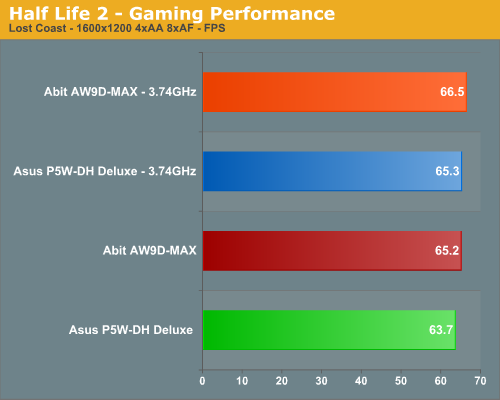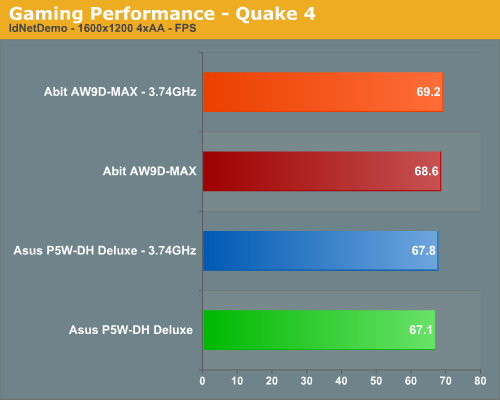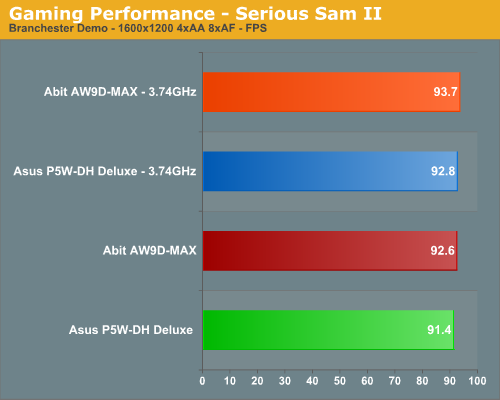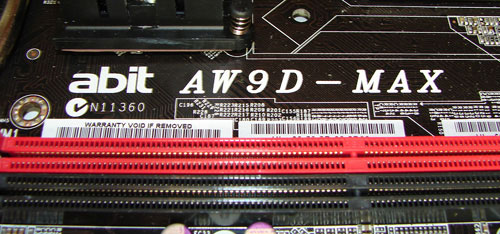Abit AW9D-MAX: When "Beta" MAX is a good thing
by Gary Key on September 8, 2006 3:10 AM EST- Posted in
- Motherboards
High-Resolution Gaming Performance
For high-quality gaming performance, we also tested at 1600x1200 with 4xAA /8xAF. As just about anyone familiar with current games can tell you, benchmarking with a single high-end graphics card at these stressful settings will make just about any recent game GPU limited. That brings up one of the flaws with Intel's 975X chipset as it does not "officially" support NVIDIA SLI and these users will have to look for another solution. At this time that solution is the 7950GX2.
This card works fine on the 975X chipset except for a couple of anomalies in our test scores on the ASUS board that is under investigation currently. The charts below only includes single GPU performance using a 7900 GTX currently, but you can refer to our Conroe Buyers Guide results to see the performance improvements that SLI/CrossFire and a E6700 bring to the table. We will update our results with the 7950GX2 shortly and will have ATI CrossFire results in our next 975X review.



If you're serious about gaming at a high resolution with all the eye candy enabled, you will most certainly want to run a multi-GPU configuration (with NVIDIA's 7950 GX2 counting in our book as a multi-GPU solution). Looking specifically at the Abit board, its relative positioning did not change at the higher resolution settings. The spread among these motherboards is extremely minor with differences up to 1% at most due to our GPU limitation. Really, you would still be hard pressed to tell the difference between these boards in gaming performance.
Quick Take
Our preview of the Abit AW9D-MAX now shows a motherboard capable of living up to its heritage. In fact, this is probably the best performing Abit board we have tested since the IC7-MAX3 board that was one of our all time favorite Intel 875 boards. While we noticed a few minor issues with the BIOS during a rigorous test schedule, we have to state once again that the overall performance of the board is extremely impressive at this time. However, our enthusiasm is curtailed by the layout and expansion options on the board. While the minimalist and almost legacy free nature of the board may appeal to some, we found the lack of useable PCI slots to be a major drawback during operation with this board. We did come to accept this limitation as we found the on-board audio solution to be very good for most purposes and accepted the fact that this board would probably not be used in a home theater setup. That still does not excuse Abit for not including more PCI slots or at least changing the location of the single slot provided.
If the typical enthusiast utilizes a CrossFire arrangement then you lose both a PCI Express X1 slot and the only PCI slot. This will probably not be acceptable to most enthusiasts as that PCI slot usually contains an aftermarket sound card or possibly a TV tuner card among other things. Even with a single PCI slot open your choices are still limited if you want to use the system as a media station unless you upgrade to a PCI Express based TV tuner card or plan on utilizing the on-board audio solution. Our other issue has to do with the location of the floppy connector (it could just go away in our opinion) and the 4-pin 12V molex connector (needed for CrossFire) at the bottom of the board next to the audio max connector. The location of the first two SiL3132 SATA ports could be debated but we did not have any issues in using the ports if they were plugged in before we installed our Creative X-FI card. The same holds true for the first two Intel ICH7R SATA ports as our ATI X1900XT card almost blocked these two ports.

We do commend Abit on providing Dolby Master Studio support via the Realtek ALC-882M, dual Gigabit Ethernet controllers that use the PCI-E interface, an e-SATA port, a very effective silent OTES 2 cooling system, and their impressive µGuru technology for overclocking and full system monitoring/control capabilities. Abit has made great improvements in their BIOS capabilities since we last reviewed a motherboard from them. They ensure us we will have a public release BIOS shortly so we can provide a full report on the board's capability and compatibility with a host of components. We found the current overclocking capabilities to be excellent for a 975X based motherboard and stability at the maximum overclocks were superb. We expect continued refinement of the BIOS along with additional performance and overclocking improvements in the near future. It appears after a couple of years of disappointments that Abit has finally delivered a board worthy of the MAX name; we just wish they would have maxed out the PCI slots also.
For high-quality gaming performance, we also tested at 1600x1200 with 4xAA /8xAF. As just about anyone familiar with current games can tell you, benchmarking with a single high-end graphics card at these stressful settings will make just about any recent game GPU limited. That brings up one of the flaws with Intel's 975X chipset as it does not "officially" support NVIDIA SLI and these users will have to look for another solution. At this time that solution is the 7950GX2.
This card works fine on the 975X chipset except for a couple of anomalies in our test scores on the ASUS board that is under investigation currently. The charts below only includes single GPU performance using a 7900 GTX currently, but you can refer to our Conroe Buyers Guide results to see the performance improvements that SLI/CrossFire and a E6700 bring to the table. We will update our results with the 7950GX2 shortly and will have ATI CrossFire results in our next 975X review.



If you're serious about gaming at a high resolution with all the eye candy enabled, you will most certainly want to run a multi-GPU configuration (with NVIDIA's 7950 GX2 counting in our book as a multi-GPU solution). Looking specifically at the Abit board, its relative positioning did not change at the higher resolution settings. The spread among these motherboards is extremely minor with differences up to 1% at most due to our GPU limitation. Really, you would still be hard pressed to tell the difference between these boards in gaming performance.
Quick Take
Our preview of the Abit AW9D-MAX now shows a motherboard capable of living up to its heritage. In fact, this is probably the best performing Abit board we have tested since the IC7-MAX3 board that was one of our all time favorite Intel 875 boards. While we noticed a few minor issues with the BIOS during a rigorous test schedule, we have to state once again that the overall performance of the board is extremely impressive at this time. However, our enthusiasm is curtailed by the layout and expansion options on the board. While the minimalist and almost legacy free nature of the board may appeal to some, we found the lack of useable PCI slots to be a major drawback during operation with this board. We did come to accept this limitation as we found the on-board audio solution to be very good for most purposes and accepted the fact that this board would probably not be used in a home theater setup. That still does not excuse Abit for not including more PCI slots or at least changing the location of the single slot provided.
If the typical enthusiast utilizes a CrossFire arrangement then you lose both a PCI Express X1 slot and the only PCI slot. This will probably not be acceptable to most enthusiasts as that PCI slot usually contains an aftermarket sound card or possibly a TV tuner card among other things. Even with a single PCI slot open your choices are still limited if you want to use the system as a media station unless you upgrade to a PCI Express based TV tuner card or plan on utilizing the on-board audio solution. Our other issue has to do with the location of the floppy connector (it could just go away in our opinion) and the 4-pin 12V molex connector (needed for CrossFire) at the bottom of the board next to the audio max connector. The location of the first two SiL3132 SATA ports could be debated but we did not have any issues in using the ports if they were plugged in before we installed our Creative X-FI card. The same holds true for the first two Intel ICH7R SATA ports as our ATI X1900XT card almost blocked these two ports.

We do commend Abit on providing Dolby Master Studio support via the Realtek ALC-882M, dual Gigabit Ethernet controllers that use the PCI-E interface, an e-SATA port, a very effective silent OTES 2 cooling system, and their impressive µGuru technology for overclocking and full system monitoring/control capabilities. Abit has made great improvements in their BIOS capabilities since we last reviewed a motherboard from them. They ensure us we will have a public release BIOS shortly so we can provide a full report on the board's capability and compatibility with a host of components. We found the current overclocking capabilities to be excellent for a 975X based motherboard and stability at the maximum overclocks were superb. We expect continued refinement of the BIOS along with additional performance and overclocking improvements in the near future. It appears after a couple of years of disappointments that Abit has finally delivered a board worthy of the MAX name; we just wish they would have maxed out the PCI slots also.










56 Comments
View All Comments
Jedi2155 - Friday, September 8, 2006 - link
Oh heck yea! I thought I was going to have to go with Asus P5B deluxe board mainly due to the color scheme as I'm a bigger fan of Black & Blue than Black & Red. Too bad for all those other people who prefer red tho.wolf550e - Friday, September 8, 2006 - link
How much is Scyhte paying you?Madellga - Friday, September 8, 2006 - link
Actually his review is very neutral and not a PR stunt.This space is to discuss the review itself and the product there.
If you want to make such comments I suggest paging him, instead of writing here on the open.
Gary Key - Friday, September 8, 2006 - link
Actually I paid NewEgg $51.99 for the pleasure of using the Scythe Infinity. :) Scythe does not advertise with us and the picture was published based upon numerous reader requests wanting to know how the larger heatsinks fit on the boards. I still love and use the Tuniq 120 but until they are readily available again my current air cooling favorite is the Infinity. Just in case it comes up, the E6600 was also bought from NewEgg and is not supplied by Intel.
DigitalFreak - Friday, September 8, 2006 - link
LOL! First time I've ever heard a motherboard described as "menacing".
mostlyprudent - Friday, September 8, 2006 - link
I am very pleased to see Abit producing a strong board again. Two of my older systems are still running with Abit boards (4 years old and 2.5 years old) with no issues. I am still deciding, but the PCI slot issue is a tough pill to swallow.BTW, there is a type-o in the last paragraph on page 3 "Although this 'typcially' worked..."
GoatMonkey - Friday, September 8, 2006 - link
I used to be a big Abit fan. I bought 5 Abit motherboard for myself over the years, and built at least 4 other systems for friends with Abit motherboards. Unfortunately, over half of them failed after several months of use. Abit really needs a good warranty and some good testimonial of quality to get me back.yyrkoon - Friday, September 8, 2006 - link
ABIT has a decent warranty policy, the only problem is that they exchange 're-certified' boards for your new one.We've had to deal with ABITs RMA a couple of times in the last two years, and while they did replace the boards, the process was slow, and again, they replace it with a re-certified board. However, it turned out it wasnt the motherboard that was bad at all, but a ATI videocard (pre-PCIE, and additional card power), that was drawing too much power from the AGP slot.
ABIT forums, while not owned or paricipated by any ABIT workers (that I know of), is second to none. If you cannot find someone on ABITs forums to help with an issue, then said issue is rare, or hard to trace.
I'm finding that more, and more, that motherboards dont really go bad (short term), but often 'broken' motherboards are configured improperly by the user, that has limited experience with that brand, or a user that really hasnt a clue how to properly setup a motherboard. This doesnt include the rare chance of a dead out of the box motherboard, or the random hard to troubleshoot other than motherboard issues, and I've recently experience the latter here myself (an Asrock board that would lock up within three days, no BSoD, and nothing standard fixed the problem).
The main reason why I like ABIT, is that usually ABIT boards have stability that is second to none, and they perform very well.
granulated - Friday, September 8, 2006 - link
I know that the Scyhte Infinity is approx 12cm x 12cm but blimey !It's looks massive !
yyrkoon - Friday, September 8, 2006 - link
Gary, was wondering if yo ucould confirm if ABIT boards with eSATA, and a SIL 3132 controller will in fact work with a SATA port multiplier. From all the researching Ive done for the last year or so would indicate so, but I would like ot make sure before investing loads of cash in an external RAID 5 array, only to have it not work.